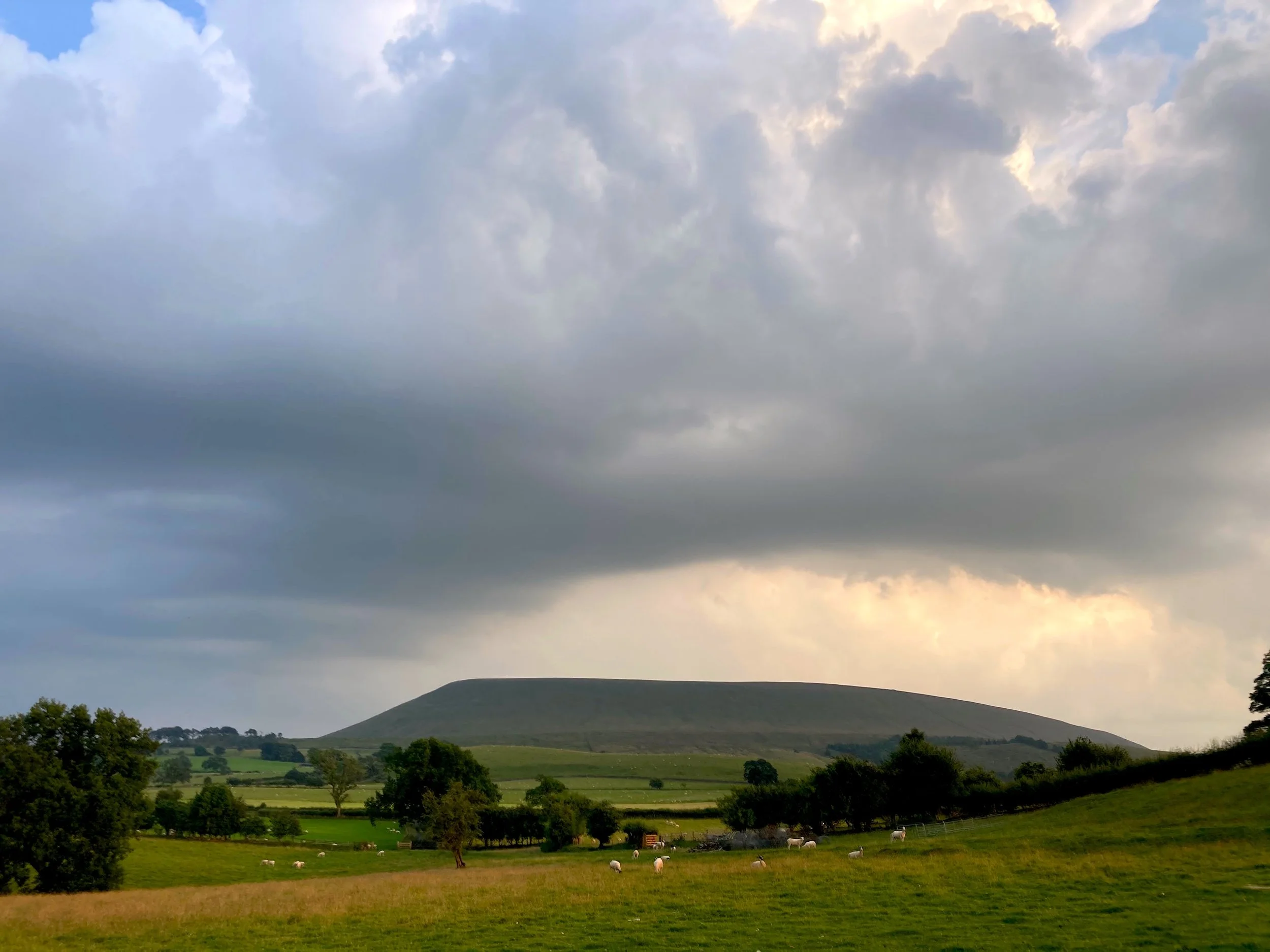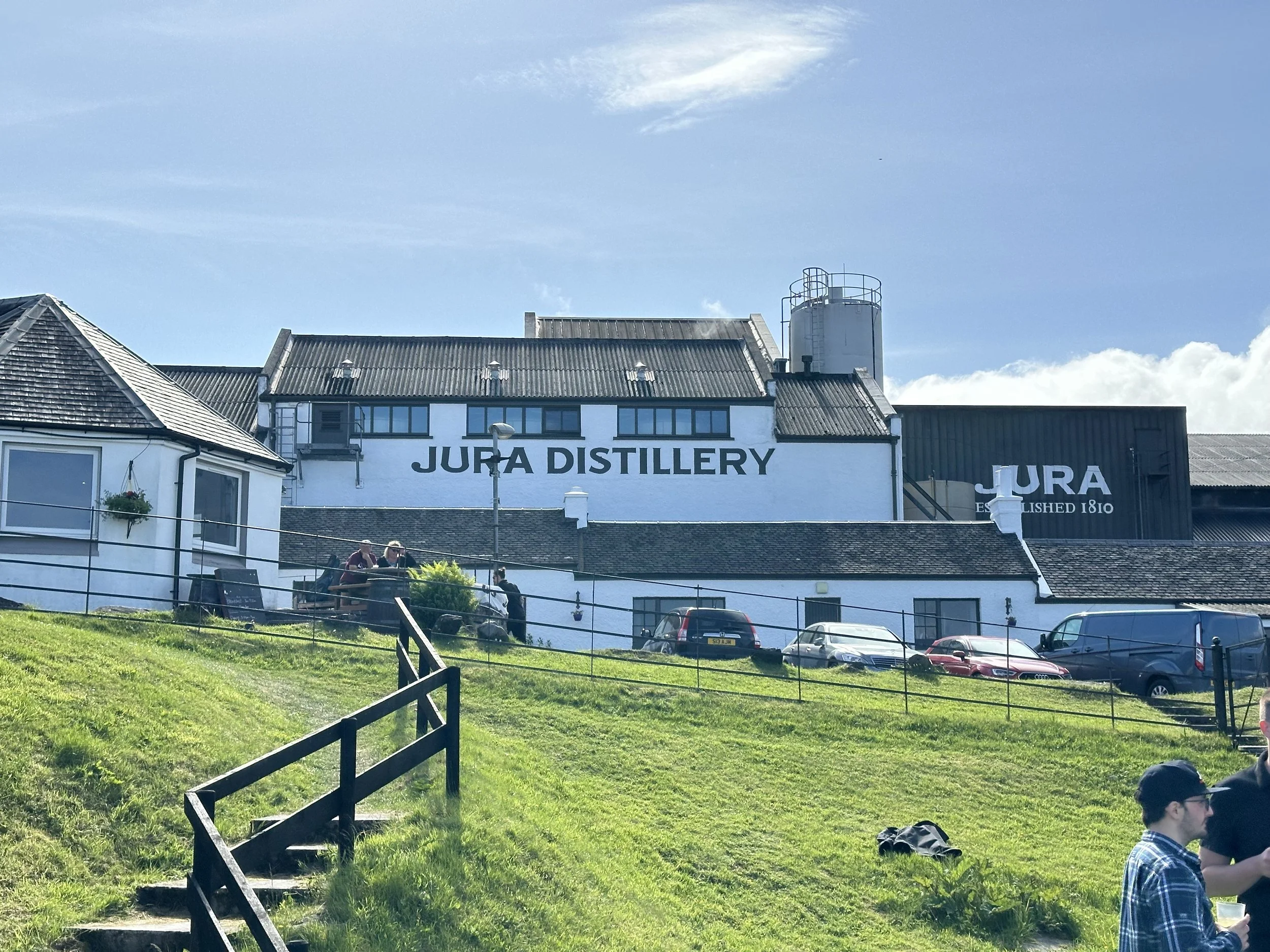Hip flask hikes: Pendle Hill
Our intrepid reporter prepares to do battle with ‘Big End’. Photographs: Chris Moss
Lancashire’s famous “witches’ mountain” marks the natural frontier of the true north. Local lad Chris Moss waxes lyrically and walks diagonally into the mists and mires
When I’m breathless, what I need is a sit down, a cuppa, a nip. What I get on this spring morning at the top of the zigzag that takes me towards the summit of Pendle Hill is a fist of wind. Nature saying: get this in your lungs, you’ll be alright. I suppose it’s fitting. After all, this is Lancashire’s best-known prominence, a lump of gritstone, shale and chert that you can see from many miles around. It’s the home of upland farmers, quarrymen, turvers, drovers, millworkers, witches. You’d expect it to be hard as nails.
English mountains are most often a misty blur. The land rises slowly, mist and rain fall all too easily, and even the Pennines, the mother range, usually looks more of a dank barrier than beauty spot. Pendle Hill is different. It’s an outlier, an irruption removed from the main chain, and it has clearly defined slopes – most notably the sharply angled northeast face, which drops from the summit known brusquely hereabouts as, simply, Big End.
‘Hares dash and dart. Curlews trumpet the hesitant season.’
Most people start from one of two villages: quaint Barley, a honeypot in the shadow of Big End; or Downham, a postcard-perfect cluster of cottages that still has a lord of the manor. I start from home. Mid-way through lockdown, I rented a farmhouse just north of Pendle Hill, and my windows on the front-side are filled with the mini-mountain day and night – because it’s always a tad blacker than the sky. I wake to it, dream it, have nightmares about it, never quite get over it.
The track from the house winds gently across a few sheep-fields, past the side of a deep ravine or clough, and then on to rough scrubby lowlands. Hares dash and dart. Curlews trumpet the hesitant season. At the bottom of the hill I take a view: the steep footpath, the quarry at the top, the weather. “Scud” could well derive from “scut”, a hare’s tail, and the clouds shift at speed. There’s nothing for it, though, so I bend into the incline and get moving. The higher I get the more I am in the lee of the wind, and it feels calmer. Dry stone walls attack the angle like Inca roads, but the zigzag allows me to traverse, reducing the effort, inviting pauses and ponderings.
What do you think about when you climb? I seem to oscillate between nothing and everything. Just walking upwards and finding a rhythm going can take up enough energy to still the mind. At rest points, elbows on the zigzag, I look out over the north – my house, the Bowland Fells, higher peaks of the Lake District, Yorkshire’s Three Peaks, and the lesser elevations of the Dales. Northerners and Scots like to debate where the north begins – the Trent, the Mersey, Manchester, Hadrian’s Wall – but Pendle Hill feels like a natural barrier. On one side is industry or at least post-industry: capped mines, converted mills, canals, towns. On the other – where I am – fields and lanes, empty places and open vistas.
‘If the escarpments suggest vulcanism and great collisions, the top evokes glaciation and time. Pendle Hill is over 300 million years old’
In half an hour I’m up at the lip of the hill – where I get that gusty punch from a westerly – and then on the top, a wide and level plateau of mire and bog and heathland, with views in all directions. If the escarpments suggest vulcanism and great collisions, the top evokes glaciation and time. Pendle Hill is over 300 million years old, and has been smoothed and worn and worried by ice and climate. I turn and aim for a place I know where the walls enclose a stone bench. Peewits, corvids and skylarks flit about on squalls.
Chris’s house with Pendle Hill looming in the background
The shelter is partial. The drystone wall dampens the wind but there is a bit of rain now. I hunker, drink a hot tea and eat half a cheese balm. A quick nip of un-peated anCnoc 12-year old – it would be rude not too – and off I stride towards the trig point. I recently chatted to a walking therapist (yes, it’s a job) and she told me that hillwalking was not all about summits and achievements. I agreed. But here I am, wading into the sodden gale just to have stood, for the umpteenth time, at the official high-point – 1,827 feet (557 metres) above sea level, just shy, apparently of the official 1,969 feet of an “official” mountain - but I invite pen-pushing measurers to join me on a midwinter tramp.
A small crowd of grinning walkers is gathered around the trig. Just beyond I can see the patches of forest framing the reservoirs serving the good folk of Burnley, Colne and Nelson. Even when there are droughts everywhere else in Britain, East Lancashire seems to get a regular dousing of rainfall. Old books tell of “brasts”, places where rain seeped into the hill, built up and then burst out, creating landslips and waterfalls.
Rather than head down in a hurry, using the knee-jolting staircase, I opt for a slow descent via the edge of Big End, while taking in the views of the milltowns. The cloud is low and darkening but visibility is good. I can make out Winter Hill’s TV antenna, the giant Granadaland needle high above Bolton. I can see the Jubilee Tower at Darwen and Peel Tower (as in the famous Prime Minister and founder of The Met) near Bury. These past two years, since moving here, I have chased these landmarks, mapping my territory, searching for roots – and stories.
‘I hunker, drink a hot tea and eat half a cheese balm. A quick nip of un-peated anCnoc 12-year old – it would be rude not too – and off I stride towards the trig point’
Pendle Hill is bursting with them. The most infamous one being, of course, the saga of the witches condemned for casting murderous spells, then tried and hanged at Lancaster. Today we know this to be a story of abuse, corruption, sexism and religious extremism; the women were victims of a conspiracy. Many modern women say they love and respect them and want to reclaim them as, yes, witches – as in individual, different, socially rebellious women.
A different type of nonconformism gave the hill its most celebrated moment of transfiguration when, in 1652 (just forty years after the witches), George Fox reached the top and “saw the sea bordering upon Lancashire. From the top of this hill the Lord let me see in what places he had a great people to be gathered.” He went on to found the Quaker movement. I can see Preston, Blackpool Tower and the same sea. Can that kind of religious experience even happen now?
Since then, the hill has been criss-crossed by Chartists and feminists, access campaigners and socialists, workers and walkers, dreamers and drifters. A local rambling group, the Pendle Radicals, celebrates the great lives of less well-known heroes of the borough. One of their treks honours the memory of Learie Constantine, the Trinidadian cricketer who signed for Nelson in the Lancashire League and later became the UK’s first black peer. They plan on a new route that will remind people that the first translator of The Communist Manifesto, Renfrewshire-born Helen Macfarlane, lived at Burnley. She’d have had a thing or two to say about witchfinders and women’s rights.
‘The hill has been criss-crossed by Chartists and feminists, access campaigners and socialists, workers and walkers, dreamers and drifters’
We’re all looking for stories, at least some of the time. In my case, I know that there’s more than innate curiosity in the mix. I left Lancashire in 1987 and didn’t come back to live here for thirty-three years and a bit. Am I home on Pendle Hill? Not quite. I’m from the West Lancashire Plain, the mining area between Liverpool and Manchester. But from up here I can take stock and keep an eye on horizons, weather-permitting.
Pendle Hill has been ‘smoothed and worn and worried by ice and climate’
I’ve had my fill of the panorama. It’s time to go down. Leave the sheep and the lapwings to their lofty home. Pendle Hill from my windows is serene and simple and settled; when I’m on it, it’s alive and boisterous and faintly unsettling. All hills are strange, sometimes ominous, always impenetrable. They outlive us by a near-infinity of years and are unmoving and silent while we are always flitting and holding forth. “Pen” is the Celtic word for ‘hill’. In Saxon times, the word was “dun” or “dhul”. We say “hill”, which is of Germanic origin. All our peoples are celebrated in this mighty mound of hard ground. Translated, its name is “Hill Hill Hill”. Pendle Hill – so good they named it thrice. Beat that New York.
Chris Moss is a travel writer based in Lancashire









